
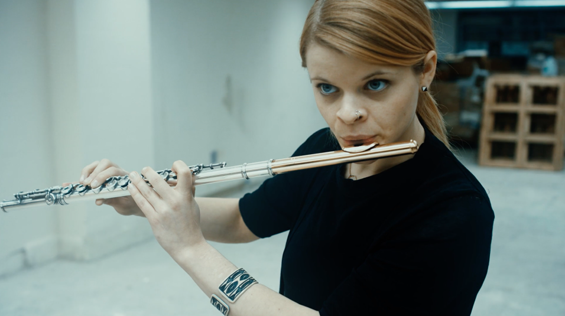
photo: Mike Kohlbrenner and Bart Cortright
SPOTLIGHT 32: LAURA COCKS / ELLEN GIBLING / RAPHAEL WEINROTH-BROWNE
textura is thrilled and honoured to feature flutist Laura Cocks, harpist Ellen Gibling, and cellist Raphael Weinroth-Browne in its thirty-second ‘Spotlight,' with each artist represented by a superb, recently issued album: field anatomies (Cocks), The Bend in the Light (Gibling), and Worlds Within Live (Weinroth-Browne). textura is deeply grateful to the artists for contributing to the article.
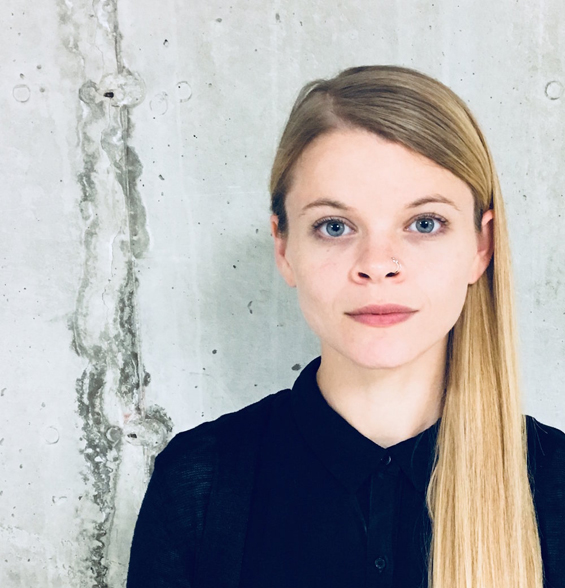
photo: Julia Den Boer
LAURA COCKS
Who: While growing up in the sweet, weird sprawl of the midwest, I once had a teacher who taught me that the answer to a question could be that the question was the wrong question. That lesson is my educational background.
My educational background also involves watching teachers embrace the richness of the weirdness of their students and fortifying that weirdness so fully that whole new lessons in the unknown could take shape. I also had a teacher who required I wear stockings and skirts and button-down shirts to flute lessons, where I also was not allowed to wear my hair pulled back and had to remove my piercings. Once she made an appointment for me so that I could dye my hair brown. This teacher taught me how to count and the alchemy of how to turn work into play and back into work again. In the end, she didn't care at all about clothing, but cared about the stakes of following-through, which is a very big part of my educational background.
I lived with two different teachers of mine, one in Ohio and one in England. The former was in the living room of a dear mentor and now cherished friend who taught me about the power of collectives and why it is important to sit in a circle and just howl sometimes. The latter taught me about the sheer force of what it feels like to be believed in; she also taught me a lot about alpacas, as this home wherein I stayed was an active alpaca farm that required wearing waist-high gaiters and a golf cart to feed the animals prior to playing flute all day.
For the past ten years, I've been living and working in New York City, where I play chamber music most days. In 2013 I co-founded TAK ensemble—a chamber group that focuses on new and experimental works and direct collaboration with artists—and my colleagues in this ensemble and the folks we work with are really my greatest teachers and inspirations. My educational background continues to find me and shift daily.
What: I'm most excited by the unknown in music—a precipice, a cusp of possibility or physicality. Oftentimes this means there's some sort of challenge in the preparation of a work, like learning a new way of playing and engaging with my instrument or developing ways of playing that are familiar into those that feel wild and seemingly unnavigable. To welcome new ways of sound-making—of navigating—requires that performers and listeners invest in the idea of raw possibility—vibrant feelings, tender griefs of past and future, peripheries of joy… There's a risk in opening up to that possibility and that unknowing, and that feeling of risk, embodied within music, is what makes me feel most alive.
With that said, I'm not sure that my music really differentiates me from others—perhaps it does the opposite? Most often, I'm drawn to works and modes of performance that feel intensely physical and deeply embodied. Any sound I make has a history with and connection to my body—which inherently traces it to the listening and performing bodies of others. Bodies are incredibly varied, and at the same time bodies hold so much similarity in systems, in patterns, in relationships to our histories… To play in communion with these systems and patterns, to me, fundamentally makes the experience one that can be shared. I find this to be especially true for the flute, wherein the literally vital systems of breath are so present in the instrument's resistance-free timbre.
This presence of physicality, and a physical virtuosity of playing, is one component of what the work that TAK does that is so compelling to me. Each individual player brings an immense level of intensity to their playing—and also to myriad other aspects of their musicianship—and, having played together for almost a decade, there's also a shared intensity that's unique to when the five of us play together—as though we slip into this space in which we trust ourselves as a unit to be open to the risks of finding that physical, musical precipice.
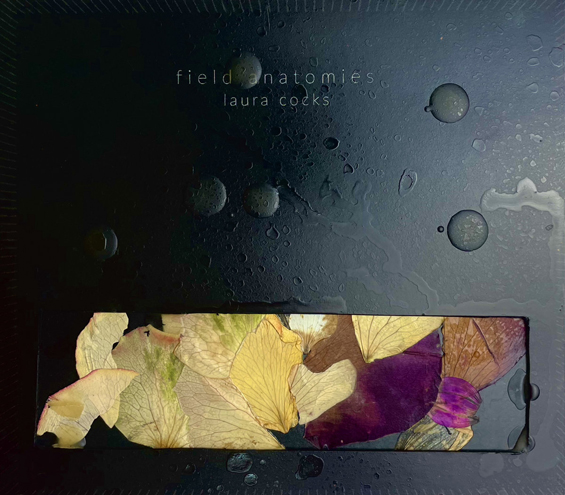
Currently: I'm immensely excited to be releasing my first solo record, field anatomies, on February 22nd on Carrier Records. It features five truly incendiary works from composers David Bird, Bethany Younge, Jessie Cox, DM R, and Joan Arnau Pàmies. Each work truly feels like an experience in world-building, formulated by immense investigation, incredible imagination, and the curiosity to look at the flute with completely fresh architectural eyes. From the hypothetical geographies of David Bird's Atolls, to the fabrication of vast theoretical architectures of Jessie Cox's Spiritus, to the total reconfiguration of the instrument into its distilled components of Joan Arnau Pàmies' Produktionsmittel I and the bodily reconfigurations of Bethany Younge's Oxygen and Reality, to DM R's haunting and expansive rebellion that is You'll see me return to the city of fury, each work has dramatically influenced my performance practice and relationship with the flute over the years. I owe a lot to these piece and these composers, and I'm really elated to be able to share them on field anatomies.
Right now TAK is also preparing for its next album release on April 1st on our in-house label, TAK editions. On the album is Ashkan Behzadi's concert-length song cycle written for TAK, Love, Crystal, and Stone. The album is being released as a hybrid book/recording, with the libretto—poetry by Federico García Lorca—in its original Spanish and in the Farsi translations of Ahmad Shamlou that deeply influenced Ashkan. Paired with these poems are a series of intensely evocative paintings by Mehrdad Jafari—each time I see these paintings, I quite literally freeze up. They are beyond captivating. The book also features essays by scholar Saharnaz Samaeinejad and is designed in collaboration with the Chicago-based design house Sonnenzimmer.
TAK is also currently workshopping a handful of exciting new commissions. We're ecstatic to be collaborating on new works by Michelle Lou, Seth Cluett, Eric Wubbels, DMR & Joy Guidry, Tyshawn Sorey, Lewis Nielson, and Natacha Diels in the coming months. The first of these to be premiered is Eric Wubbels' Interbeing, which exists as a folio of many movements for different configurations of players, audience, video, and corporal sounding sculptures. We'll premiere one potential iteration of Interbeing on May 21st in NYC.
I'm also grateful to have some exciting projects coming up with several other amazing collaborators and ensembles this year! Jessie Cox is currently writing a new solo for contrabass/bass flute that we'll premiere in April and a new long-form piece for Sun Ra Arkestra, which I'm totally over the moon about playing contrabass flute on. In April, Weston Olencki and I are touring a set of two duos that we wrote for ourselves, titled Music for Two Flutes, in which the parameters of flute-playing are extremely compromised and the sonic results are unspeakably amazing. I'm really grateful to continue collaborating with incredible colleagues like Mario Diaz de Leon, Sugar Vendil, Charlotte Mundy, Henry Mermer, Henry Fraser, Madison Greenstone, Tim Angulo, Talea Ensemble, The [Switch~] Ensemble, Fonema Consort, Collide-o-scope Music, and the Walden School Players to make some more gut-wrenching music happen before the end of this season!
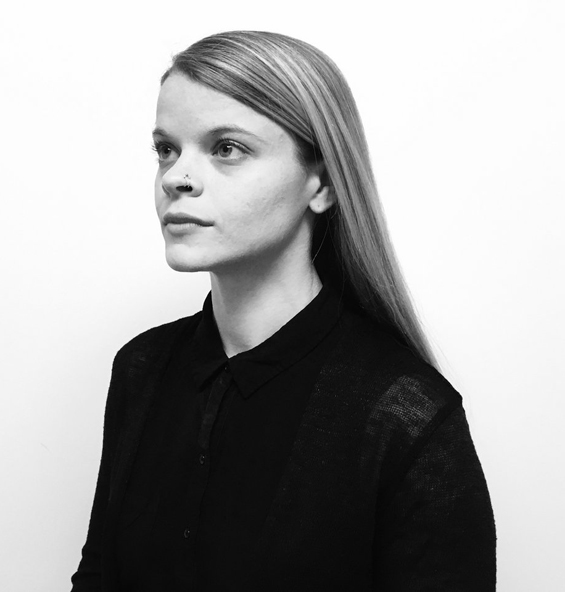
photo: Julia Den Boer
Musical philosophy: I think just be in it, let yourself totally go, and play with folks that it's okay to do this with. Find something, or don't, but definitely feel something. Music is the best.
Favourite artists and strongest influences: It feels immensely hard to pick two favourites, and I thought about this question quite a lot—I will say that I had two really profound experiences with artists that impacted me deeply:
Whenever I listen to Chavela Vargas, I learn new things about how our feelings and bodies ride out together in our sound-making. In every sound is a legible body, and in that body is a deep constellation of history, of feeling, and of shared memory. I strive to play the flute as Chavela sings.
One winter I watched someone kill a stag and got into a terrible altercation. That night I dreamt that I showed up on the doorstep of Ornette Coleman who took me in, gave me a glass of water and a place to sit, and we talked until I felt loved again. This, of course, only happened in my dream, but it was a very influential experience for me, and I am grateful to Ornette.
Recordings that have deeply affected me: When I was in my early teens, I went through a phase in which I thought that I should burn every CD that the public library had in the classical section to my family's computer, and I'd listen to the CDs that I got from the library on the drive home. I wish I remembered the performer and the label of these specific recordings, but I checked out a two-disc Xenakis record once, thinking it was extremely cool that this person's name began with an “X” and knowing nothing else about the composer. I think I listened to Palimpsest maybe thirty times that week?
I knew at that age, maybe fourteen or so, that I felt really happy when music was doing something different—when the idea of change or difference or possibility was able to contrast against the expectations and stasis that one awakens to around that time in life. This recording shook me awake to what this contrast and possibility could feel like within classical music. This chance encounter with Palimpsest helped carve out a crucial early understanding for me: that the music I was most excited by at that time, stuff that was generally more punk/DIY, did in fact translate into classical possibility.
There's also a live recording of Cecil Taylor, Andrew Cyrille, Sam Rivers, and Jimmy Lyons—Music for these times in which we inhabit—in Paris in November of 1969 that taught me some of my deepest lessons in form.
A memorable event, concert, or experience: I'm not sure that this is really a proper response for this question, but I mean it with incredible sincerity—every time I play with TAK feels like this. Every single time. The gift of being able to make music with Marina, Charlotte, Ellery, and Madison pretty much floors me every rehearsal, every performance, even every meeting. There's an intense excitement to try things and around experiencing things together that just feels so hopeful, so ready for the world, and so full of possibility. Each of the players in TAK is an incredible musician and incredible caretaker. There's such deep risk-taking, deep play, and deep commitment, that when we gather, I feel as though, literally, anything is possible—and I really, truly mean that.
site: LAURA COCKS
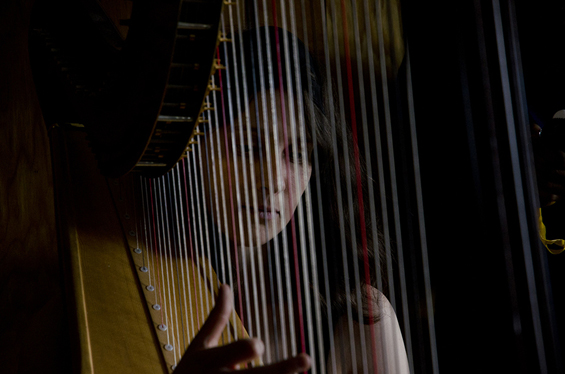
photo: Maxime Brouillet
ELLEN GIBLING
Who: I grew up in K'jipuktuk, Halifax, on the east coast of Canada, and have been based here ever since, with an interlude of five years in Montreal. I've studied classical harp at McGill University and Irish Traditional Music Performance at the University of Limerick in Ireland. I've also studied improvisation at the Halifax Jazz Festival's Creative Music Workshop and have had most of my traditional music education in Irish sessions and informal gatherings.
What: I play both pedal and lever harps, and I find myself making music in three main directions—free improvised music, Irish traditional music, and classical music. I love interdisciplinary projects and am delighted whenever something comes up involving theatre, film, dance, or circus. I sometimes wonder if I would do better to choose one direction and specialize, but I find it's both practical and interesting to be open to all of it. However, Irish traditional music is what feels most like home to me.
Currently: My main focus at the moment is the March release of my album The Bend in the Light, which consists of twelve tracks of solo harp music. Some are traditional tunes, some are original compositions, but most are newly-written tunes by composers I have encountered through playing Irish traditional music. The arrangements were created through a series of coachings and explorations with mentors in Ireland and Canada and especially with Shannon Quinn, my producer and project companion. This is my first time releasing my own music at this scale, and I'm very curious to experience the process and see how it is received. I am cautiously looking forward to touring this repertoire following the release!
I have a few projects brewing which have been repeatedly put on hold by the pandemic and which I am desperately hoping will finally see the light of day in 2022. I'm particularly crossing my fingers for an east coast tour with the folk duo The Bombadils, a west coast tour with fiddler Olivia Barrett and singer Lizzy Hewitt, recording and releasing a new album with New Hermitage, and the premiere of Everywhere the Edges choreographed by Rebecca Lazier (featuring dance, circus arts, the sculpture of Janet Echelman, and the music of New Hermitage).
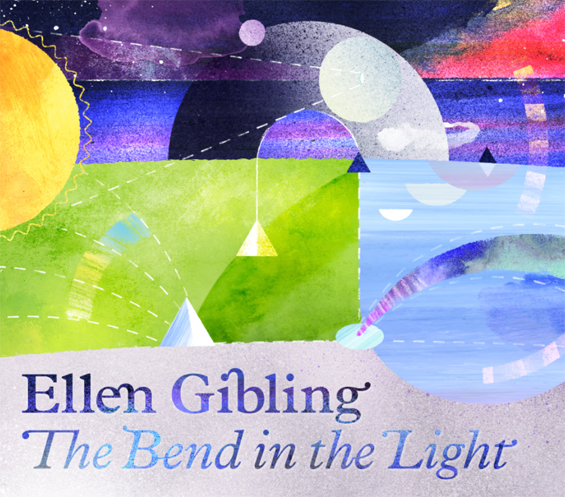
Musical philosophy: I don't have an over-arching musical philosophy, but I've been thinking a lot about how beneficial it is for both the musical landscape and individual creativity when musicians are deeply invested in each other's work. I've been inspired lately by a few musicians who seem to be constantly excited about new artists they admire, performances they've seen, what their friends are creating, and ideas they've picked up from conversation or observation of others. Being currently stuck in a time when it is much more difficult to foster these kind of connections to other artists, I'm especially motivated to shift my priorities when things open up again. While I will always value my personal practice time, I want to dedicate more energy to exchange of ideas, informal music making, seeking out new art (especially from people with different backgrounds to me), and just simply showing up to as much as I can. If I focus on expanding what I'm taking in, an expanded output will follow naturally from there.
More broadly, my musical philosophy is deeply shaped by the approach taught at the Creative Music Workshop by Jerry Granelli and the community he fostered. Jerry's lessons are difficult to summarize, but some ideas I revisit regularly are deep listening, comfort with loss of control, consciousness of the aggregate sound of an ensemble, the value of experiencing both vulnerability and basic dignity in performance, and focusing more on the process of clearly communicating and working with an idea rather than the process of generating it (“hearing what you're going to play next,” or “first idea – best idea”).
Favourite artists and strongest influences: Unsurprisingly, some of my strongest influences have been my harp teachers. I've been fortunate to have some of my favourite musicians as teachers, and Jennifer Swartz and Alisha McMahon are two of those. Jennifer is principal harp with the Orchestre symphonique de Montréal. She has a magically warm and assured touch on the instrument, and when seeing her perform I'm always amazed by both her powerful presence and the intimacy of her music, no matter the size of the venue. I only really notice her astonishing virtuosity in hindsight because I'm too absorbed in the moment by her sincerity and ease. When I think of Jennifer's teaching I'm reminded of the beauty and value of taking lots of time to explore the most minute subtle details of tone and intention.
Alisha is an Irish traditional harpist who was my teacher in Ireland. I love her rhythmic feel and her style of her ornaments, variations, and accompaniment. The first time I heard her playing I actually cried instantly because it was so beautiful. She strikes a very tasteful balance between innovation and tradition where she's constantly exploring new ideas without tugging the listener out of the form or breaking the spell. When I think of Alisha's teaching, I'm inspired to improvise more variations within tunes, to work on cultivating a light and effortless but immovable groove, and to take risks with more elaborate ornamentation.
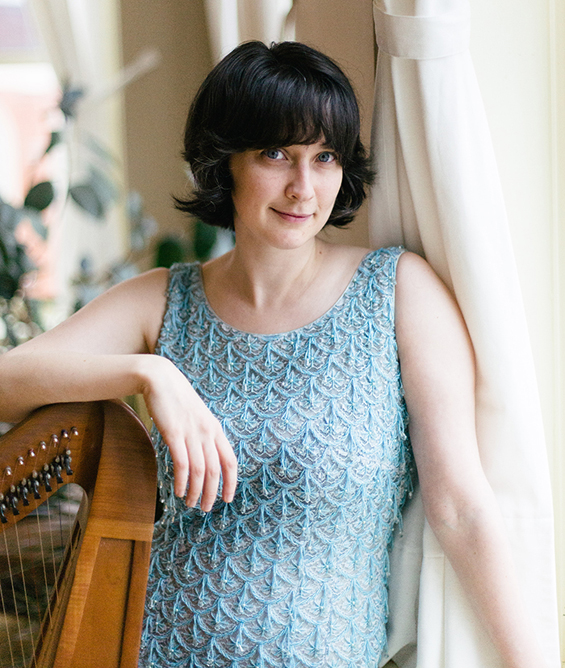
photo: Marie Roy
Recordings that have deeply affected me: Ryan Molloy's recordings of Irish traditional tunes played solo on the piano have been extremely inspiring to me. He has such a precise and thoughtful approach, and I love that he can incorporate all sorts of classical influences and surprising harmonic ideas such that it feels like the tune was always meant to be played that way.
I'm also very attached to Martin Hayes and Dennis Cahill's The Lonesome Touch, which was one of the first trad albums I obsessed over. I keep returning to it especially for the powerful simplicity of the accompaniment and the attention to phrasing. I'm reminded that perception of speed is about more than beats per minute – I have the impression that Hayes can make a slow pulse feel like it's buzzing and a fast pulse feel like molasses if he chooses, simply through subtleties of phrasing.
A memorable event, concert, or experience: When I was a teenager, I had the opportunity to play in a combined professional and youth symphony concert of Respighi's Pines of Rome. I remember being completely bowled over by the experience of listening (during my many bars of rest) to that incredible music from within the orchestra—especially the big finale with the offstage brass. I fully believed on that day that I would spend the rest of my life seeking out that experience as much as possible. As it turns out, I don't do much orchestral playing anymore, but the memory of that feeling remains vivid. I don't think I realized before then that music had the potential to be that overwhelming.
A more recent highlight for me was during a performance at a festival in Quebec. My friend Erin Dempsey and I had opened for a band of quite famous Irish trad musicians, and they generously invited us up at the end for a big encore. We were playing tunes I didn't know, and I had never spoken to any of them before so was astonished when I actually felt very comfortable. The guitarist was extremely clear in his musical communication and was listening intently to me, and I felt effortlessly able not only to coordinate chords with him but be playful about it. As someone who does not always find it easy to talk to strangers, I am fascinated by the mysteriously clear pathways of communication that have been opened for me through music.
site: ELLEN GIBLING
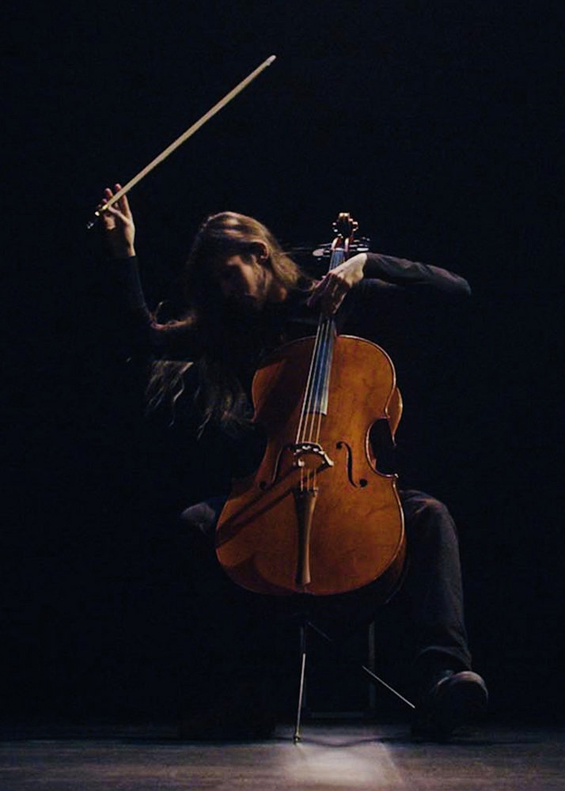
photo: Andrew Robillard
RAPHAEL WEINROTH-BROWNE
Who: I grew up in Ottawa, Canada and attended the University of Ottawa for my undergraduate degree in cello and the Glenn Gould School in Toronto for my graduate studies (artist diploma). I'm currently living in Ottawa. In addition to studying cello, I also learned a number of instruments growing up, which I continue to play to this day: piano, guitar, bass guitar, and drums. I've definitely taken a very unorthodox path in my musical career. My main aspiration before I entered music school was to play metal, but when I began university all of a sudden I was studying classical music throughout the day and gigging in the evenings (mostly with Musk Ox at the beginning, but also as a sideman with different local artists/bands). In the early days, I cut my teeth using my classical chops in a wide range of contexts, including folk, pop, rock, metal, jazz, Balkan music, Indian Bollywood music, spoken word, theatre, dance, and more; I was trying to be as versatile as possible and often relied on improvisation to get through unfamiliar set-lists and unconventional situations. I also quickly became active as a session musician and spent a great deal of time working for as many people as I could. I gained a lot of crucial experience as a hired gun, and that shaped my unique voice on the cello; it also led to greater opportunities, such as being recruited by Leprous to record and tour with them.
What: I've composed and released music in a very wide range of styles and genres. My output as a solo artist is largely centred around the cello. Some of my work in this context is influenced by the twentieth-century classical repertoire for unaccompanied string instruments (see composers such as Kodály, Britten, and Ysaÿe) as well as progressive metal and Middle Eastern music; it's focused on virtuosity, rhythmic complexity, and invention on the instrument. I also use looping and effects pedals to create more layered, minimalist pieces that paint lush, evocative soundscapes. In almost all of my solo work, I use non-standard cello tunings to open up new sound worlds and a different vocabulary from what is normally expected from the instrument.
With my cello/voice duo The Visit, I've incorporated a riff-based approach to cello playing that utilizes the full range of the instrument and even extends it below the usual low C of the bottom string. Introducing this “metal” approach into an otherwise contemporary chamber context has contributed to the uniqueness of our style.In my trio Musk Ox, we also employ a similar prog metal language alongside contrapuntal lines more typical of classical music, while using chamber folk instrumentation. My group Kamancello is the only kamanche-cello duo of which I'm aware, and our music is all completely improvised.
My compositions for classical soloists and ensembles tend to be highly rhythmic and virtuosic, having little in common with the melodic or harmonic language of the classical canon, and instead relying frequently on modality. There are some common threads throughout all of my work, namely the convergence of metal, classical, and Middle Eastern influences into a distinctive musical language. All of my output has quite a serious tone and emotional intensity, generally expressed through long epic pieces with multiple subsections or implied movements.
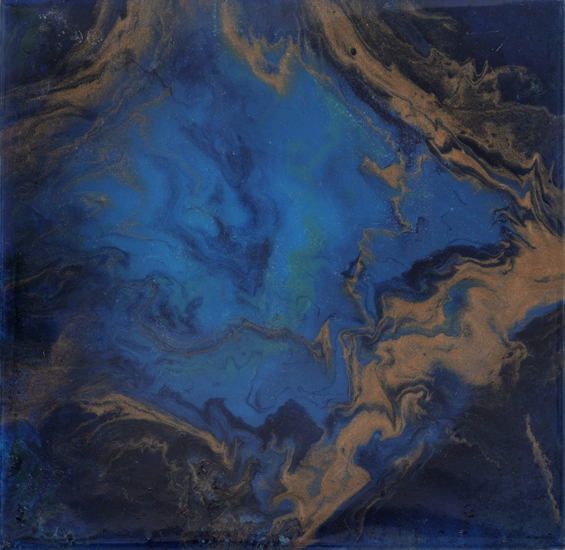
Currently: Many of the main projects I've been pursuing this year are the result or continuation of work that began in 2019. During that year, I completed my debut solo album Worlds Within, which came out in early 2020, and also recorded albums with my groups The Visit and Musk Ox. Despite the pandemic, 2020 proved to be a good year for Worlds Within, so I decided to extend its lifespan by recording Worlds Within Live, a live recording of the aforementioned record with high quality video footage of the entire performance. The new Musk Ox album Inheritance came out around the same time in summer 2021. In the fall, I resumed work on the material I had recorded for The Visit but set aside due to other commitments. This is my main focus now, and I believe that it represents a logical stylistic continuation of both our first album (Through Darkness Into Light) and Worlds Within.
Since the pandemic, my focus has shifted almost entirely to recording, both for my own projects and for my work as a session musician. I built a home recording setup in 2020, which was a huge game-changer. In 2021, I had my busiest year for session work, with over forty different projects. I was approached by artists from all over the world and noticed that the type of music coming my way was of greater interest to me and of superior quality than in past years.
In mid 2020, I also began to shift my thinking around social media and decided to share much more material than I had ever done before, which proved to be effective. I made an effort to connect with the community that had been engaging with my music and provide a glimpse into my creative process with regular “raw” content as opposed to polished music videos. I shared both original material and covers. I've noticed that these efforts have led to an increase in my online audience, which has more than doubled since the beginning of the pandemic. I began a TikTok account and also enjoyed considerable growth there. I know that many are reticent about this platform, but it's actually my favourite. I highly recommend it to musicians trying to expand their audience and reach new people.
While opportunities to perform live have been much more limited, I think I've mostly managed to stay productive during this period and actually grow my network and profile, particularly as a solo artist.
Musical philosophy: I think that as a young artist it's easy (especially nowadays with the current numbers game of streaming and social media) to be focused on getting bigger, being recognized, and making a name for oneself, but over time, it becomes clearer that the path of a musician needs to be one of humility and generosity. It's important to remember (and easy to forget) that it's not really about you, but rather about how the music speaks through you and how you enable yourself to be a conduit for its energy.
I believe in giving everything away and leaving nothing in reserve, whether it's onstage or in the studio. I think what I fear the most is delivering a safe performance, where everything goes smoothly but where I don't play to my edge. The ability to share music is a gift that we should try to give fully, without holding back. I would like to be generous both in performance and in creative output, as well as in helping others to achieve their own musical goals. I hope to be able to set a positive example in the same way that so many exceptional artists have inspired me. I really believe that the role of music and art in general is to inspire us to live our fullest lives as human beings and to understand ourselves and the world in ways that we can't necessarily access through other means. Music is able to illuminate what might be hidden and unlock doors that would otherwise remain closed to us.
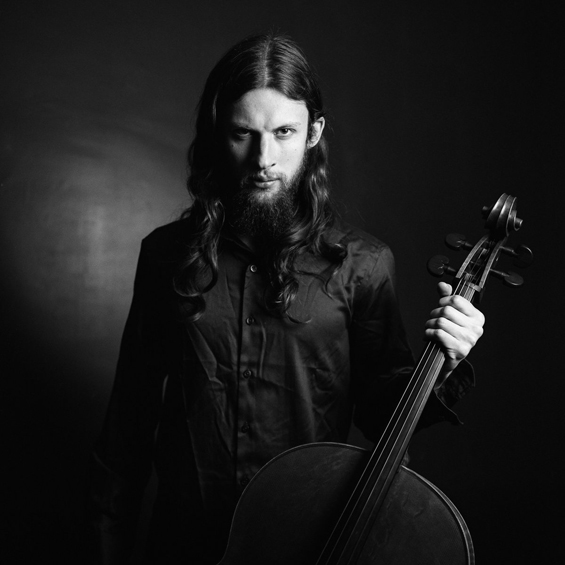
photo: Jonathan Lorange
Favourite artists and strongest influences: Arvo Pärt. I grew up hearing recordings of his music at home. Both his music and personality (from what I know) transcend everyday triviality; they seem connected to something deeper. Listening to and playing his music has the effect of making one feel that time is slowing down or disappearing altogether. It evokes a space beyond or outside of life itself. The gravity and austerity of his work, as well as his tintinnabuli approach to harmony have greatly influenced my own writing.
Discovering Giovanni Sollima through the rabbit hole of YouTube was a revelation. When I first heard his compositions and playing style, something clicked for me, and it was like the missing piece that I needed to chart my own course as a non-traditional cellist. His music is timeless, somehow almost ancient and yet also forward-thinking, exotic, and familiar, and always so well-suited to the cello. His playing style is fearless and unrestrained, which I love, and his seductive and playful sound is immediately recognizable. I think my work in The Visit and some of my solo pieces such as In The Face of Adversity owe a lot to Sollima.
Recordings that have deeply affected me: There have been so many that left an indelible mark, but I'll mention two that have greatly influenced me as a cellist.
One album that has had a lasting impact on my life is Nu by the Québécois cellist Claude Lamothe. I got the CD when I was just beginning cello lessons. I always had this sense that I wanted to do something different from pure classical music, even as a young kid just getting started, and this album was what fortified that belief. The range of exploration and innovation that Lamothe deploys on the cello throughout its 11 tracks is staggering, and while I couldn't see him performing the pieces, hearing his playfulness and virtuosity was like a kind of auditory magic and made me want to create a comparable album one day.
The enigmatic and elusive offering from the late great American cellist David Darling, simply titled Cello, is possibly the album I've listened to the most in my life, and it left a profound impact on the way I approach the cello as a creative artist and composer. Having already been familiar with some of Darling's other work (such as the similar and also excellent album Darkwood), I impulsively picked up Cello at an obscure record shop here in Ottawa named Sounds Unlikely. The record is framed by the recurring movements “Darkwood I – III”, which feature only a solemn and lonely melody with no accompaniment, and another triptych, also spread across the album, consisting of the tracks “No Place Nowhere”, “Two Or Three Things (for Jean-Luc Godard),” and “In November,” all of which paint a landscape of bleak gloom with their densely layered chords.
“Fables” and “Indiana Indian” seem to instill a sense of childlike wonder and awe; tracks such as “Lament” and “Choral” evoke indescribable sorrow, and “Psalm” and “The Bell” speak the language of hopelessness and despair itself. Throughout, Cello exudes a starkness and austerity that is beautifully haunting, and for me it has never lost its staying power, even after hundreds of listens. This is perhaps due to its oblique and mysterious nature—a vision shrouded in impenetrable darkness. This is the album that inspired me to create layered cello arrangements, both on my own records and on sessions for clients. Worlds Within owes a great deal to Cello, both in its atmospheric quality and elemental landscape, but also its form, with recurring pieces containing subtle variations. I'm not sure I would be the musician I am today without this album.
A memorable event, concert, or experience: Playing my Schryer cello for the first time and immediately falling in love with this instrument. Having this cello gave me an incredible boost of confidence, and its sound has really become my voice. I'm very proud to be playing it and continually searching to uncover its greatest potential.
site: RAPHAEL WEINROTH-BROWNEFebruary 2022![]()